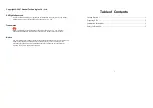
Page
85
February 2010
Appendix B
GLOSSARY
ACK
Acknowledgment.
Access point
An access point is the connection that ties wireless communication devices into a
network. Also known as a base station, the access point is usually connected to a
wired network.
Antenna Gain
Antennae don't increase the transmission power, but focus the signal more. So
instead of transmitting in every direction (including the sky and ground) antenna
focus the signal usually either more horizontally or in one particular direction.
This gain is measured in decibels
Bandwidth
The amount of "transportation" space an Internet user has at any given time.
Bridge
Collision
avoidance
A network node characteristic for proactively detecting that it can transmit a
signal without risking a collision.
Crossover cable A special cable used for networking two computers without the use of a hub.
Crossover cables may also be required for connecting a cable or DSL modem to
a wireless gateway or access point. Instead of the signals transferring in parallel
paths from one set of plugs to another, the signals "crossover." If an eight-wire
cable was being used, for instance, the signal would start on pin one at one end of
the cable and end up on pin eight at the other end. They "cross-over" from one
side to the other.
CSMA/CA
CSMA/CA is a "listen before talk" method of minimizing (but not eliminating)
collisions caused by simultaneous transmission by multiple radios. IEEE 802.11
states collision avoidance method rather than collision detection must be used,
because the standard employs half duplex radios—radios capable of transmission
or reception—but not both simultaneously. Unlike conventional wired Ethernet
nodes, a WLAN station cannot detect a collision while transmitting. If a collision
occurs, the transmitting station will not receive an ACKnowledge packet from
the intended receive station. For this reason, ACK packets have a higher priority
than all other network traffic. After completion of a data transmission, the
receive station will begin transmission of the ACK packet before any other node
can begin transmitting a new data packet. All other stations must wait a longer
pseudo randomized period of time before transmitting. If an ACK packet is not
received, the transmitting station will wait for a subsequent opportunity to retry
transmission.
CSMA/CD
A method of managing traffic and reducing noise on an Ethernet network. A
network device transmits data after detecting that a channel is available.
However, if two devices transmit data simultaneously, the sending devices detect
a collision and retransmit after a random time delay.






































